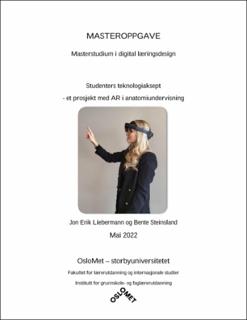| dc.contributor.advisor | Swendsen, Håkon | |
| dc.contributor.author | Steinsland, Bente | |
| dc.contributor.author | Liebermann, Jon Erik | |
| dc.date.accessioned | 2022-08-15T13:09:57Z | |
| dc.date.available | 2022-08-15T13:09:57Z | |
| dc.date.issued | 2022 | |
| dc.identifier.uri | https://hdl.handle.net/11250/3011925 | |
| dc.description.abstract | Problem statement: «How does the implementation of flipped classroom and augmented reality affect students’ perceived learning outcomes in anatomy».
Background: The subject of anatomy is being allocated less teaching hours and teachers are looking at modern technology to make teaching and learning more efficient. Research criticizes the effectiveness of traditional teaching and argues for more student-active teaching methods. Newer digital tools are getting better and more accessible. Augmented reality is one of the tools that has the potential to improve the teaching and learning of anatomy. The Flipped Classroom method turns traditional teaching upside down. This provides more room for student-active learning in the classroom activities.
Purpose: The purpose for this masters thesis is to investigate how the implementation of augmented reality affects the students’ perceived learning outcomes in anatomy.
Method: The study uses a qualitative method with a hermeneutic-phenomenological approach with a focus group interview as the data collection method. Braun & Clarke’s six steps in thematic analysis have been used to present the informants’ views.
Theoretical foundation: The results from the interview were analyzed in light of our analytical framework «model for students’ technology acceptance» (S-TAM). This framework is a continuation of the Technology Acceptance Model (TAM) 1 and 2 developed by Davis and Venkatesh, as well as Scherer’s interpretation of TAM towards an educational context in the model for teachers’ technology acceptance. S-TAM looks at the various factors that affect students’acceptance of technology and the relationships between them. The model summarizes these relationships as the students’ perceived learning outcomes.
Conclusion: In this project, we have used the technology acceptance model (TAM) as a base for our model for students' technology acceptance, called S-TAM. S-TAM describes various factors that affect students' technology acceptance in a learning context. S-TAM has been used as a framework for discussing the influence of various factors in the implementation of technology in learning. Cognitive load is a factor in the implementation of new technology. Time designated for training in the use of augmented reality, the importance of prior knowledge and clear structure in the classroom activities are important factors for perceived learning outcomes. Both group collaboration and visualization of anatomical structures contribute to increased perceived learning outcomes. Augmented reality has the potential for use in anatomy teaching, but requires custom made software and good lesson planning. | en_US |
| dc.description.abstract | Problemstilling: «Hvordan påvirker implementering av omvendt undervisning og augmented reality studenters opplevde læringsutbytte i anatomiundervisning?»
Bakgrunn: Anatomifaget blir tildelt stadig færre undervisningstimer og undervisere tar i økende grad i bruk moderne teknologi for å effektivisere læringen. Forskning kritiserer effektiviteten av tradisjonell undervisning og argumenterer for mer studentaktive undervisningsformer. Nyere digitale verktøy blir stadig bedre og mer tilgjengelige. Augmented reality er et av verktøyene som har et potensiale til å forbedre og effektivisere anatomiundervisning. Omvendt undervisning er en metode som snur opp ned på den tradisjonelle undervisningen. Dette gir mer rom for studentaktiv læring i klasseromsaktivitetene.
Hensikt: Hensikten med masteroppgaven er å undersøke hvordan implementering av augmented reality påvirker studentenes opplevde læringsutbytte i anatomiundervisning. Metode: Studien bruker kvalitativ metode med hermeneutisk-fenomenologisk tilnærming med fokusgruppeintervju som datainnsamlingsmetode. Braun & Clarke sine seks trinn i tematisk analyse er benyttet i dataanalyse for å få frem informantenes synspunkter.
Teoretisk forankring: Resultatene fra intervjuet ble analysert i lys av vårt analytiske rammeverk «modell for studenters teknologiaksept» (S-TAM). Dette rammeverket er en videreutvikling av Technology Acceptance Model (TAM) 1 og 2 utviklet av Davis og Venkatesh, samt Scherer sin videreutvikling inn mot utdanningskontekst i modell for lærers teknologiaksept. S-TAM ser på de ulike faktorene som påvirker studenters teknologiaksept og relasjonene mellom dem. Modellen sammenfatter disse relasjonene i studentenes opplevde læringsutbytte.
Konklusjon: I arbeidet med denne oppgaven har vi videreutviklet technology acceptance model (TAM). Vår modell for studenters teknologiaksept, kalt S-TAM, beskriver ulike faktorer som påvirker studenters teknologiaksept i en undervisningskontekst. S-TAM er brukt som rammeverk i drøfting for å tydeliggjøre disse faktorenes påvirkning ved implementering av teknologi i undervisning. Kognitiv belastning er av betydning ved implementering av ny teknologi. Tid til opplæring i bruk av augmented reality, betydningen av forkunnskaper og tydelig struktur i klasseromsaktivitetene er viktige faktorer for opplevd læringsutbytte. Både gruppesamarbeidet og visualisering av anatomiske strukturer bidrar til økt opplevd læringsutbytte. Augmented reality har et potensiale til bruk i anatomiundervisning, men krever tilpasset programvare og god undervisningsplanlegging. | en_US |
| dc.language.iso | nob | en_US |
| dc.publisher | OsloMet - Storbyuniversitetet | en_US |
| dc.subject | Augmented reality | en_US |
| dc.subject | Anatomyx | en_US |
| dc.subject | Technology acceptance models | en_US |
| dc.subject | Flipped classroom | en_US |
| dc.subject | Learning outcomes | en_US |
| dc.subject | Anatomy | en_US |
| dc.subject | Teknologiaksept | en_US |
| dc.subject | Omvendt undervisning | en_US |
| dc.subject | Utvidet virkelighet | en_US |
| dc.subject | Læringsubytter | en_US |
| dc.subject | Anatomi | en_US |
| dc.title | Studenters teknologiaksept - et prosjekt med AR i anatomiundervisning | en_US |
| dc.type | Master thesis | en_US |
| dc.description.version | publishedVersion | en_US |
| dc.source.pagenumber | 132 | en_US |
| dc.subject.nsi | VDP::Samfunnsvitenskap: 200::Pedagogiske fag: 280::Andre pedagogiske fag: 289 | |
| dc.subject.nsi | VDP::Teknologi: 500::Informasjons- og kommunikasjonsteknologi: 550 | |
